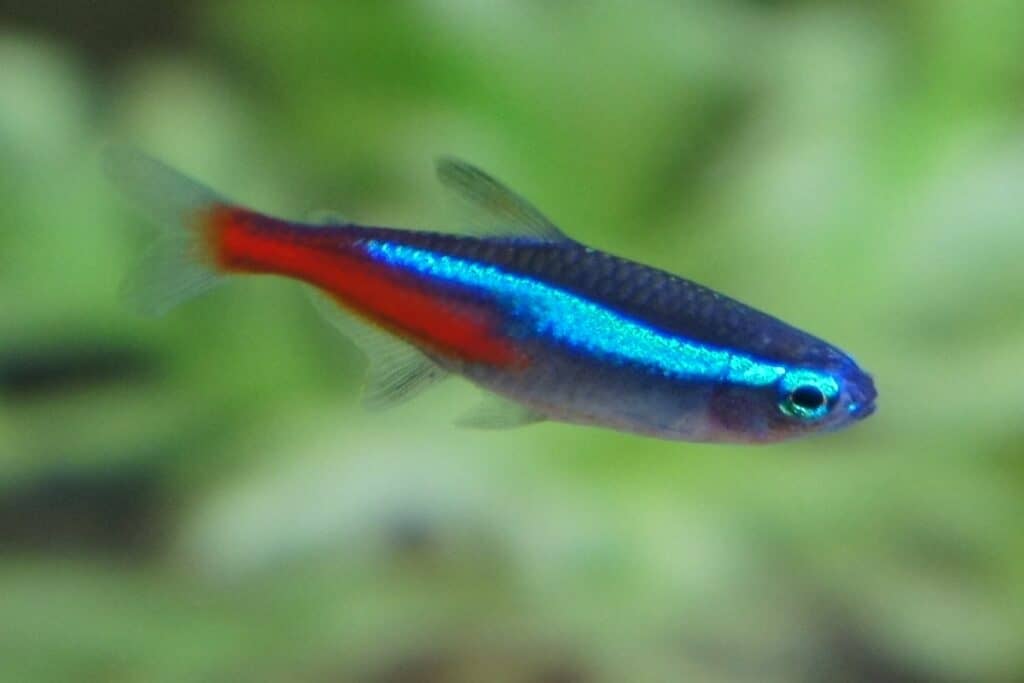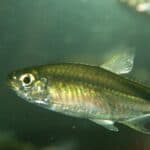Neon Tetras are the life of any freshwater tank. These beautiful fish are enjoyed by hobbyists everywhere and bring a touch of brightness to any home. Their eye-catching coloration — silver and white at the abdomen, light blue at the back — compliments all the colors in the aquarium.
This guide provides everything you need to know about caring for Neon Tetras, including how to set up their tank and what to feed them.

Species Summary
The Neon Tetra (Paracheirodon innesi) is a species of tropical freshwater tetra belonging to the Characidae family. These tetras are found in South America. The extent of its occurrence is still somewhat unknown, but it is known from different populations in Brazil, Peru, and Colombia.
The species occurs in various slow-flowing tributaries, such as streams and flooded forest areas. This tetra is commonly found amid vegetation, dry leaves, roots, and driftwood in clear and dark waters rich in tannins.
Furthermore, they are highly sought-after fish for their unique colors and radiance, which gives them their common name. In short, they are active animals that like to swim throughout the aquarium and should be kept in a group in a spacious aquarium.
But like many tetras, the Neon Tetra can be prone to nipping at other fish if kept alone or under stress. A good rule of thumb is to keep them in a shoal to feel safer with a minimum of six individuals.
Neon Tetra Care Guide
The fish is resistant and easy to care for, but that does not mean that one can neglect to understand its species, habits, and behaviors. As with any other species, this fish has its own peculiarities which must be addressed.
Tank Size
Although these Tetras do not reach a large size, they must be kept in a school of at least six individuals, hence the need for an aquarium with reasonable space. Therefore, they should inhabit aquariums over 21 gallons, with dimensions starting at 31″ x 11″ x 15″.
Tank Mates
They are peaceful fish and coexist without problems with other animals; they can live with countless other fish species in a community aquarium. This species is friendly and gets along incredibly well with other fish.
One should avoid keeping aggressive and larger species of fish with Neon Tetras, as they could injure the smaller fish or compete directly for food. Additionally, anything that fits in the mouth of a Neon Tetra can become prey.
Although rare, this species may bite fish with flashy and exuberant fins, such as Bettas and Guppies. In this case, avoiding using fish with these characteristics is best.
The best tank mates for Neon Tetra include Rasboras, Bristlenose Pleco, Ember Tetra, Honey Gourami, Cardinal Tetra, Green Neon Tetra, and Black Neon Tetra.
Same Species Tanks
The Neon Tetra can frequently be found residing solo in large aquariums, planted tanks, or biotope-type aquariums that mirror the species’ natural habitat.
The fish is a great addition to a well-decorated aquarium. When kept in a shoal, the fish are known to form beautiful movements and develop a stunning color contrast.
Water Parameters
This fish species is incredibly resistant and can support a wide range of parameters. They are, however, susceptible to pollutants in the water and the accumulation of organic matter.
The perfect temperature for keeping the Bleeding Heart Tetra in an aquarium is 75 to 82 F. The ideal pH range is between 4.0 to 7.2, and hardness is 18 – 215 ppm.
What to Put in Their Tank
Individuals looking to keep a Neon Tetra healthy must maintain an aquarium heater and an appropriate filtration system.
The aquarium decoration is not critical to guaranteeing success in maintaining the species. However, having a tank that mimics their conditions in the wild is incredibly beneficial.
Neon Tetras also do well in densely planted aquariums. A sandy, dark substrate will further enhance their colors. You should leave a wide-open space for them to swim freely.
Common Diseases
Tetras are susceptible to Ich and other diseases related to low immunity when they experience stress.
Food and Diet
Tetras, including this species, are predominantly omnivorous with a high tendency towards carnivores, feeding on anything of animal origin that will fit in their mouth.
The Neon Tetra’s diet in the wild primarily consists of a variety of worms, crustaceans, and insects. They will also consume plant matter secondary to other food sources.
Also, a good combination of using high-quality commercial feed and live, fresh or frozen foods such as bloodworms, brine shrimp, or daphnia will make these fish appear much more vivid.
You should set a time to feed your fish an amount that can be consumed quickly. These fish are always hungry, so giving them a varied, high-quality diet is important.
Lifespan
Under optimal conditions with a stable environment and proper diet, this animal can live for up to six years though the average is five.
In nature, these animals have a shortened life span due to their susceptibility to diseases, attacks from other animals, and environmental causes.
Appearance
Neon Tetras exhibit a classic tetra shape body, with an electric blue color on the middle-upper part of the body and a longitudinal red spot, starting from the middle of the body towards the tail, on the lower half. These vivid colors gave the fish its neon name, and that radiant glow is the species’ most distinctive feature.
Size
The Neon Tetra can reach 1.4 inches in length with proper care and feeding.
Behavior and Temperament
The peaceful behavior of this tropical fish species makes it ideal for community aquariums, where it can be kept with other fish of similar size and disposition.
The fish behaviour is more natural when kept in a group of at least six individuals. If you keep in pairs or trios, there may be persecution of the weakest of the group.
If these animals do not feel comfortable in the tank hidden among vegetation, rocks, and driftwood, their behavior can change. When left alone, they will become highly stressed, in a state that negatively impacts their health.
Breeding
As a fish that reproduces in an acidic pH, its reproduction can be more complicated than other fish; however, it is still simple and can be carried out commercially or accidentally in home aquariums worldwide.
The species is oviparous, with the female scattering eggs freely. In nature, its reproductive period follows the rhythm of floods, with the change in water chemistry being one of the main factors triggering the reproductive process.
The male will lead the female to release the eggs freely, which will then be fertilized by him; most of the eggs will go to the bottom of the aquarium or stay in the middle of a cluster of plants. The eggs will hatch in up to three days, and larvae will swim freely for up to 48 hours. Parents do not exhibit any parental care.
They are generally bred in breeding tanks, with something at the bottom – like a mesh – preventing the parents from eating the eggs until they are removed to another location. The fry is tiny; they must be fed with paramecium or another type of infusoria until they are big enough to accept other foods.
They are easily reproduced fish, where spontaneous reproduction can occur in any domestic aquarium, as long as the basic needs of the fish are met.
Gender Differences: Male vs Female
There is apparent sexual dimorphism in adult animals. Females are slightly larger than males and have plump bodies. Males have a straight body shape.
Neon Tetra Fun Facts
- Due to its rusticity and beauty, a viral tetra species in the aquarium can be easily confused with its cousin Cardinal Tetra. The main difference is that the Neon Tetra’s red spot is not continuous.
- Its biotope can be so full of acids originating from the organic matter of the forest that the salt content is close to zero.
- Although there are creations in Eastern Europe and Asia, in Brazil, they are caught in the middle Negro river by artisan fishers, who sell to intermediaries and distribute them worldwide.
References
FAO-FIES, 2015. Aquatic Sciences and Fisheries Information System (ASFIS) species list. Retrieved from http://www.fao.org/fishery/collection/asfis/en.
Nomura, H., 1984. Nomes científicos dos peixes e seus correspondentes nomes vulgares. In H. Nomura (ed.). Dicionário dos peixes do Brasil. Editerra, Brasília, Brasil: 27-63.
Dylvin, Y. V., Hanel, L., Fricke, R., Orlov, A. M., Romanov, V. I., Plesnik, J., … & Kochetkova, M. O. (2020). Fish diversity in freshwater and brackish water ecosystems of Russia and adjacent waters. Publications of the Seto Marine Biological Laboratory, 45, 47-116.








